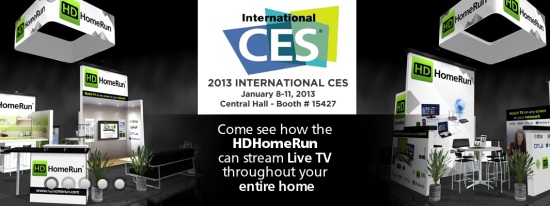SiliconDust @ CES 2013

Before CES SiliconDust teased us with a press release about DLNA + DCTP-IP enabling the HDHomeRun PRIME to expose live digital cable streams to devices without the hassle of implementing DRI. I got a chance to stop by, see the upcoming HDHomeRun products, get a demo of what will be delivered initially and talk about where Project Connect is headed long term. Some photos and a breakdown are on the next page.
New HDHomeRun Tuners
SD is introducing three new HDHR tuners later this year. The over-the-air models (ATSC/QAM & DVB-T2) will arrive faster than the CableCARD version which needs to be certified by CableLabs. Each model offers four tuners and supports real time adaptive transcoding from MPEG2 to H.264 (AVC) for each tuner. This not only offers bandwidth benefits to Wi-Fi consumption points, but also dramatically increases the number of devices that can work with the new HDHR tuners (many mobile phones/tablets do not support MPEG-2). Support for H.264 DVR recording is on the road map, but will not be supported at launch. Each tuner also provides a USB port which besides DTA support on the digital cable tuner model can be used later (we did not discuss specific timing) for attached storage potentially as a DVR or for trick-play applications.
The new form factor, which looks like a thicker DUAL, is very nice and will provide a more convenient install for structured wiring panel users because of the smaller footprint compared to the PRIME. Also, the addition of DVB-T2 to the HDHR line up should be especially interesting to HD loving European Windows Media Center users because of their options are currently very limited.
Project Connect
DLNA forms the foundation of Project Connect (i.e. accessing the live TV streams on connected devices), but SD recognizes very clearly that browsing the HDHR devices/tuners/channels via DLNA is not a great user experience so this is not the end goal, except for devices where it is the only entry point. They are planning to create “HD” apps for a myriad of platforms including Smart TVs, tablets, phones and streamers like the Roku as quickly as possible.
I saw examples of this on Windows 8 “Metro”, an Android tablet (Kindle Fire HD), and a Samsung TV. The current “HD” app is limited to simple channel browsing, but they have plans to add EPG and other desirable features in waves to make the experience more consistent with what we expect from these sorts of applications. Premium content will only be available on devices that support DCTP-IP, so platforms with native platform support like the PS3 will get it first but they also intend to address this gap at the application level over time where not provided by the platform.
Overall, I’m really excited about what SD is doing with the new models and they seem to have a well defined execution path to deliver something beyond the niche that many worried about when we saw the first hints of Project Connect. We’ll definitely be following progress closely.

Will the OTA HDHR have DLNA
Will the OTA HDHR have DLNA as well? I have read about the DLNA in several posting but it always seemed to refer to the Prime.
The new HDHRs will have
The new HDHRs will have essentially the same feature set for their respective content areas. AFAIK SD hasn’t said whether the existing DUALs will get DLNA features (obviously w/o HW transcoding) like the PRIME, but I’d guess not since it hasn’t been publicly stated.